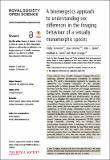Por favor, use este identificador para citar o enlazar a este item:
http://hdl.handle.net/10261/262107COMPARTIR / EXPORTAR:
 SHARE SHARE
 CORE
BASE CORE
BASE
|
|
| Visualizar otros formatos: MARC | Dublin Core | RDF | ORE | MODS | METS | DIDL | DATACITE | |

| Título: | A bioenergetics approach to understanding sex differences in the foraging behaviour of a sexually monomorphic species |
Autor: | Bennison, Ashley; Giménez, Joan CSIC ORCID ; Quinn, John L.; Green, Jonathan A.; Jessopp, Mark | Palabras clave: | Northern gannet Isotope ecology Movement ecology Bioenergetics Accelerometry |
Fecha de publicación: | ene-2022 | Editor: | Royal Society (Great Britain) | Citación: | Royal Society Open Science 9(1): 210520 (2022) | Resumen: | Many animals show sexually divergent foraging behaviours reflecting different physiological constraints or energetic needs. We used a bioenergetics approach to examine sex differences in foraging behaviour of the sexually monomorphic northern gannet. We derived a relationship between dynamic body acceleration and energy expenditure to quantify the energetic cost of prey capture attempts (plunge dives). Fourteen gannets were tracked using GPS, time depth recorders (TDR) and accelerometers. All plunge dives in a foraging trip represented less than 4% of total energy expenditure, with no significant sex differences in expenditure. Despite females undertaking significantly more dives than males, this low energetic cost resulted in no sex differences in overall energy expenditure across a foraging trip. Bayesian stable isotope mixing models based on blood samples highlighted sex differences in diet; however, calorific intake from successful prey capture was estimated to be similar between sexes. Females experienced 10.28% higher energy demands, primarily due to unequal chick provisioning. Estimates show a minimum of 19% of dives have to be successful for females to meet their daily energy requirements, and 26% for males. Our analyses suggest northern gannets show sex differences in foraging behaviour primarily related to dive rate and success rather than the energetic cost of foraging or energetic content of prey | Descripción: | 15 pages, 3 figures, 4 tables, supplementary material is available online at https://doi.org/10.6084/m9.figshare.c.5798730.-- Data accessibility: All data collected as part of this study are available from the Dryad Digital Repository: https://doi.org/10.5061/dryad.zs7h44j88 [51]. The data are provided in the electronic supplementary material | Versión del editor: | https://doi.org/10.1098/rsos.210520 | URI: | http://hdl.handle.net/10261/262107 | DOI: | 10.1098/rsos.210520 | E-ISSN: | 2054-5703 |
| Aparece en las colecciones: | (ICM) Artículos |
Ficheros en este ítem:
| Fichero | Descripción | Tamaño | Formato | |
|---|---|---|---|---|
| Bennison_et_al_2022.pdf | 815,57 kB | Adobe PDF |  Visualizar/Abrir | |
| Bennison_et_al_2022_suppl_1.docx | 182,21 kB | Microsoft Word XML | Visualizar/Abrir | |
| Bennison_et_al_2022_suppl_2.docx | 14,11 kB | Microsoft Word XML | Visualizar/Abrir |
CORE Recommender
SCOPUSTM
Citations
5
checked on 28-abr-2024
WEB OF SCIENCETM
Citations
5
checked on 24-feb-2024
Page view(s)
33
checked on 30-abr-2024
Download(s)
54
checked on 30-abr-2024
Google ScholarTM
Check
Altmetric
Altmetric
Este item está licenciado bajo una Licencia Creative Commons

